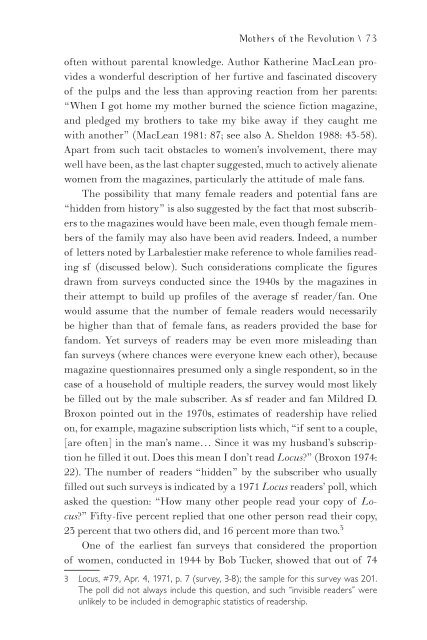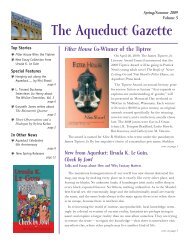Feminist Ca
Read Chapters Two and Three - Aqueduct Press
Read Chapters Two and Three - Aqueduct Press
- No tags were found...
Create successful ePaper yourself
Turn your PDF publications into a flip-book with our unique Google optimized e-Paper software.
Mothers of the Revolution \ 73<br />
often without parental knowledge. Author Katherine MacLean provides<br />
a wonderful description of her furtive and fascinated discovery<br />
of the pulps and the less than approving reaction from her parents:<br />
“When I got home my mother burned the science fiction magazine,<br />
and pledged my brothers to take my bike away if they caught me<br />
with another” (MacLean 1981: 87; see also A. Sheldon 1988: 43-58).<br />
Apart from such tacit obstacles to women’s involvement, there may<br />
well have been, as the last chapter suggested, much to actively alienate<br />
women from the magazines, particularly the attitude of male fans.<br />
The possibility that many female readers and potential fans are<br />
“hidden from history” is also suggested by the fact that most subscribers<br />
to the magazines would have been male, even though female members<br />
of the family may also have been avid readers. Indeed, a number<br />
of letters noted by Larbalestier make reference to whole families reading<br />
sf (discussed below). Such considerations complicate the figures<br />
drawn from surveys conducted since the 1940s by the magazines in<br />
their attempt to build up profiles of the average sf reader/fan. One<br />
would assume that the number of female readers would necessarily<br />
be higher than that of female fans, as readers provided the base for<br />
fandom. Yet surveys of readers may be even more misleading than<br />
fan surveys (where chances were everyone knew each other), because<br />
magazine questionnaires presumed only a single respondent, so in the<br />
case of a household of multiple readers, the survey would most likely<br />
be filled out by the male subscriber. As sf reader and fan Mildred D.<br />
Broxon pointed out in the 1970s, estimates of readership have relied<br />
on, for example, magazine subscription lists which, “if sent to a couple,<br />
[are often] in the man’s name… Since it was my husband’s subscription<br />
he filled it out. Does this mean I don’t read Locus?” (Broxon 1974:<br />
22). The number of readers “hidden” by the subscriber who usually<br />
filled out such surveys is indicated by a 1971 Locus readers’ poll, which<br />
asked the question: “How many other people read your copy of Locus?”<br />
Fifty-five percent replied that one other person read their copy,<br />
23 percent that two others did, and 16 percent more than two. 3<br />
One of the earliest fan surveys that considered the proportion<br />
of women, conducted in 1944 by Bob Tucker, showed that out of 74<br />
3 Locus, #79, Apr. 4, 1971, p. 7 (survey, 3-8); the sample for this survey was 201.<br />
The poll did not always include this question, and such “invisible readers” were<br />
unlikely to be included in demographic statistics of readership.




